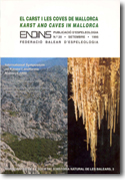|
Títol:
|
 Litología i tectònica del carst de Mallorca
Litología i tectònica del carst de Mallorca |
|
Autor/es
|
Fornós Astó, Joan Josep
; Gelabert, Bernadí |
|
Matèries en català:
|
Geotectònica -- Mallorca ; Història Natural. |
|
Matèries en castellà:
|
Geografia física -- Mallorca |
|
Matèries en anglès:
|
Geology, Structural Spain Majorca ; Natural History. |
|
Abstract:
|
La litologia i disposició estructural de les roques que conformen I'illa de Mallorca són una magnífica base per al desenvolupament dels fenomens de tipus carstic. A Mallorca hi són representats practicament sense interrupció materials des del Carbonífer fins al Pleistoce (hi manca part del Cretaci superior i Paleogen inferior). La serie té una potencia aproximada de 3.000 m, dominant ampliament, adhuc els detrítics, els diposits de tipus carbonatat, tant calcaries com dolomies, que són els que formen els relleus més importants de I'illa. L'estructuració en forma d'escates encavalcants dirigides cap al NW que va tenir lloc durant I'orogenia alpina, va donar com a resultat uns vessants SE amb pendents més suaus, els quals ja presenten una certa maduresa en el seu modelatge, mentre que els vessants NW presenten pendents més forts i un relleu juvenil. A més, el fet que a la base de les Iamines encavalcants s'hi trobin els materials impermeables del Keuper, juntament amb la disposició imbricada dels encavalcaments, suposa I'existencia de zones permeables (dolomies i calcaries del Retia i Lias) aillades per arees de materials impermeables. ; The lithology and structural setting of the rocks which form the island of Mallorca are magnificent bases on which karstic phenomena develop. Almost every geological period is continually represented here, from the Carboniferous to the Pleistocene (only part of the Upper Cretaceous and Lower Paleogene being absent). The approximate thickness of the stratigraphic sequence is 3,000 m in which carbonate deposits (not only limestones but also dolomites) constitute the most hportant lithologies. The main structure consists of thrust sheets imbricated in a NW transport direction. Such deformation tookplace during the alpine orogenia and led to SE declivities showing smoother slopes, which present today a more ancient modelling; whereas the NW slopes are steeper and their relief is younger. Furthermore, the existence of impermeable materials from the Keuper at the base of the thrust sheets, added to the overlapping setting thrusts, cause permeable zones (dolomites and limestones from the Rhaetian and Lias) to remain isolated by areas of impermeable material |
|
Font:
|
Monografies de la Societat d'Història Natural de les Balears 1995, n. 3, pp. 27-43 |
|
Identificador:
|
ISSN: 0211-2515 |
|
Tipus de document:
|
info:eu-repo/semantics/article ; info:eu-repo/semantics/publishedVersion |
|
Avís legal:
|
All rights reserved ; info:eu-repo/semantics/openAccess |

 Litología i tectònica del carst de Mallorca
Litología i tectònica del carst de Mallorca